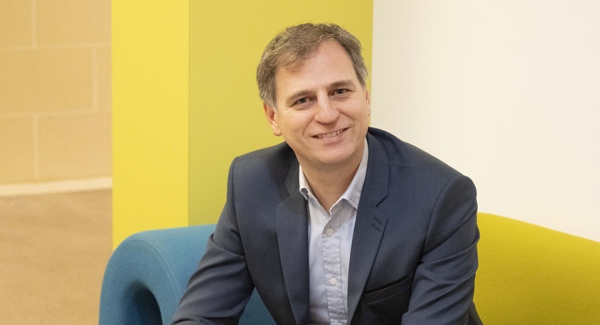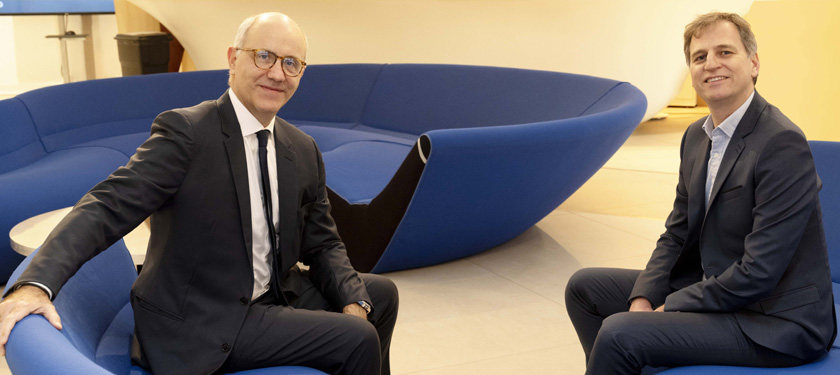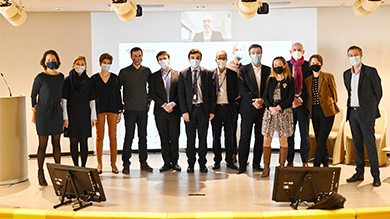European leader in the payments and transactional services industry Worldline has quadrupled its revenues since it was listed on the stockmarket in 2014, on the back of robust organic growth and as a result of its acquisition-led development. So just how has the group managed this expansion, what is its take on the payments market and the sector’s development, and how does it see the role of its banking partners in supporting its progress? CFO Éric Heurtaux gives us his analysis and talks about the keys to the company’s flourishing growth.

ÉRIC
HEURTAUX
CFO of Worldline
> click to see biography
What business sector does Worldline work in?
Worldline is the leading European company and the fourth largest group worldwide in the payments and transactional services industry. Unlike most of our competitors, we work both for banks – where we manage part of the payments value chain – and merchants to support acceptance of all payment technologies in their transactions i.e. electronic payment, meal vouchers, etc. We deliberately decided to operate on both these market segments as this approach offers a cross-industry view right across the entire ecosystem. Online sales now account for an increasing proportion of our business due to intrinsic growth for this kind of activity and as a result of our consistent development on this segment over recent years, with the acquisition of Ingenico recently for example.
What are Worldline’s main advantages?
Firstly, the size of our business is a key advantage, as economies of scale are crucial in our industry. This means we can keep production costs down and offer clients our services at competitive prices, while also providing scope to invest and innovate in new technologies. We can therefore develop new products and services, and absorb the cost of these investments across a broader client base.
Secondly, we offer an extensive portfolio of services and a global reach. We cover almost the entire payments ecosystem in more than 50 countries. We naturally have a strong pan-European footprint as we lead the market in this region, but our company has a global reach across other continents where our business is growing very quickly, particularly via bank partnerships. These partnerships are an integral component of our growth strategy, like the joint venture in Australia that we announced last year for example.
Has the Covid-19 crisis accelerated these trends?
The payments market is buoyant as traditional payment methods – cash and checks – are gradually dwindling and making way for the development of electronic payments, although they still account for around half of transactions. Underlying growth on this market is good news for all stakeholders, and the trend has further picked up as a result of the Covid-19 crisis. Partial store closures drove e-commerce, which relies exclusively on electronic payment, while stores also heavily promoted electronic payment to reduce contact. Meanwhile, governments incited consumers to use contactless card payment and raised the upper limit per transaction from €25 to on average €50 in Europe. All these changes are set to last. Additionally, the industry is growing as a result of new technologies and means of payment i.e. ApplePay, Alipay, etc.
So has the decline in physical retail been offset by the increase in online sales?
Not entirely. We have seen a widespread deterioration in retail activity, which has not been entirely offset by online sales. Restaurants have also suffered severe restrictions for several months and are unable to work normally. Another major and highly digitalized industry – tourism – has also unfortunately been at a standstill during this period.
What are your main growth drivers?
Consolidation is a key driver for market change: economies of scale are crucial to our industry, so size is the ultimate goal. Small companies end up on the sidelines and this encourages them to merge with larger groups. This is the only way to absorb the regular investments needed to comply with regulatory requirements. We have reached revenues of close to 5 billion euros and we firmly believe that this sector consolidation is set to continue.
Each new piece of regulation provides opportunities for us.
What are the challenges raised by this extremely swift growth?
Our revenues quadrupled in the space of six years since we listed the company on the stock-market in 2014, as a result of two growth drivers – organic growth and acquisition-led expansion. We have developed real expertise on integrating the companies we acquire to power a truly shared corporate culture, with entirely consistent procedures across the various entities in the group. Our approach to integrating staff – as well as clients and platforms – means that we can better navigate our growth.
What’s the secret to successful integration?
Forward planning is key. Regulatory requirements mean that there is a lag of several months between the time an acquisition is announced and its finalization, so we use this interval to prepare for folding in the new entity i.e. organization, management, building teams, setting goals, organizing resources, etc. Speed is also of the essence, as we aim to unlock at least a quarter of synergies in the first year if integration takes four years, and a third if it lasts three years. These initial results then provide the internal funding for transformation plans from the start.
Do you keep teams as they are?
Our growth means that we always need more staff. When we incorporate an entity, we reallocate our resources towards the most attractive services for our clients and the products that we want to develop. So we take a very dynamic approach to our human resources management and can offer our people varied career opportunities, which is extremely motivating. Our accreditation as a Top Employer reflects our corporate culture and our focus on our staff’s wellbeing and development.
What economic, financial and regulatory challenges do you face, and what do you need from your financial partners to help you tackle them? Is it market insight, expert advice, day-to-day support?
Regulatory pressure can be seen as a restriction, but we actually take a positive view as it creates barriers to entry for other potential newcomers – you can’t just become a payments specialist overnight. So each new piece of regulation provides opportunities for us to support our clients. For example, the European Commission is introducing new strong authentication requirements for banks and merchants, which require additional modules to standard online payment: major companies like Worldline are in a strong position to provide this service.
If we look at the economic and financial aspects, our company generates cashflow, which means we can make acquisitions. So we draw on the advice and expertise of a few banking partners like Natixis to set up and finance these transformative transactions. We work with them to determine the best opportunities for financing on the basis of our goals and our ability to pay down debt and manage our cashflow.

Christophe Carles, Senior Banker at Natixis and Éric Heurtaux, CFO of Worldline
What do you particularly welcome in the support you receive from Natixis?
We have developed a trusted relationship with Natixis, built on mutual communication at the highest level of the company, which is critical for us. Teams are extremely responsive, which is also key as our business is fast-changing, so it’s important to be able to keep up! Natixis supports us across the various stages of our development and works to what can sometimes be very short deadlines – putting together the right teams at the right time to meet our needs. Natixis is also able to seamlessly involve other banking partners in our deals. We need partners that do not necessarily look to have an exclusive role – they need to be able to work effectively with us and our other partners. A competitive solution is also of course a fundamental criterion. Lastly, we think that cross business deals will increase, so our business streams are set to develop in both ways.
How did Natixis support you in the acquisition of Ingenico for example?
Firstly, Natixis set up the bridge financing for this acquisition along with other banks. This funding deal was signed one night last spring right in the middle of lockdown after we had speeded up finalization of the deal before the health crisis became very challenging. This €2.6 billion transaction marked a significant amount and helped strengthen our offer by confirming our funding strategy. Secondly, Natixis was involved in refinancing this bridge loan via a standard bond issue in June, followed by a convertible bond issue in July. The company also supported us in presenting the offer, and we particularly welcomed its support in coordinating all the banks – with their own risk analysis – to develop shared documentation. The most recent transaction was when Natixis supported us to restructure a portion of Ingenico’s financial instruments, its revolving credit facility.
Do you plan to look into products with ESR criteria?
Yes most definitely. Environmental and social responsibility (ESR) is a crucial component in our business and we invest considerably in environmental and social aspects. Worldline is far advanced on each of the ESR indicators and our performances in this field are regularly recognized. Had we not conducted the recent deal with Ingenico, the next issue would very probably have been a green issue. For now we are focusing on the integration of Ingenico with a new scope, and on defining our strategic goals for the group, including ambitious ESR objectives. Our new strategic plan will run from 2022 and will include the range of indicators covered in this type of issue.

















